1、At a road that has more than two vehicle lanes in the same direction, the motorcycles should use the very left one.
A、Right
B、Wrong
Answer:B
2、In which of the following ways can motor vehicles avoid a tire burst?
A、Lowering tire pressure
B、Checking tires regularly
C、Removing foreign matters from the tire tread grooves timely
D、Replacing the tires that have cracks or deep cuts
Answer:BCD
3、When a motorcycle wades across the water, the braking efficiency of the brake does not change.
A、Right
B、Wrong
Answer:B
4、Which of the following is a basic requirement for rescuing the injured at the scene of a traffic accident?
A、Treat wounds first and safe life later
B、Save life first and treat wounds later
C、Help lightly wounded persons first
D、Help seriously wounded persons later
Answer:B
5、What is the meaning of this sign?
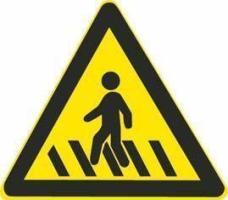
A、Speed up when the driver can not see the pedestrians
B、Speed up
C、There is a crosswalk ahead.
D、Keep driving at the same speed when you can not see the pedestrians
Answer:C
6、The continuously flashing yellow light is to warn that the driver should look and make sure it is safe to pass.
A、Right
B、Wrong
Answer:A
7、When there is no bandage for rescuing a wounded person, which of the following measures is wrong?
A、Dress the wounds with a handkerchief
B、Dress the wounds with a towe
C、Dress the wounds with cotton clothes
D、Dress the wounds with string
Answer:D
8、Which measures is correct when a motor vehicle intends to overtake
A、After overtaking, turn on the right turning light and drive back to the original lane after the necessary safe distance has been pulled away by overtaking.
B、Overtaking from the left side of the previous car
C、After overtaking, turn on the right turn light and drive back to the original Lane immediately.
D、Overtake on the right side
Answer:AB
9、What is the meaning of this sign?

A、Continuous down slopes
B、Steep downhill road
C、Steep uphill road
D、Continuous up slopes
Answer:A
10、What is the meaning of this sign?

A、No honking the tweeter
B、No honking the woofer
C、Should honk
D、No honking
Answer:C
11、What is the meaning of this sign?

A、Bump road
B、High outburst road
C、Low-lying road
D、Hump bridge
Answer:B
12、What should the driver do if he/she encounters pedestrians in this situation at an intersection?
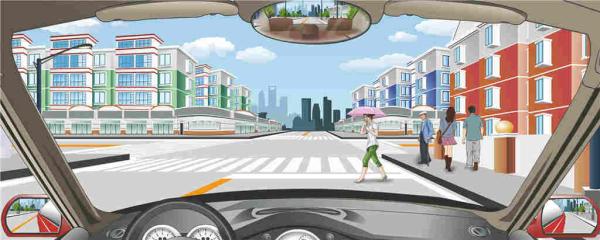
A、Slow down promptly and stop to yield
B、Sound the horn to warn the pedestrians to yield
C、Speed up and pass in front of the pedestrians
D、Turn on the headlamps to warn the pedestrians to yield
Answer:A
13、What is the purpose of checking before driving?
A、Confirm whether the tyres of motor vehicles are damaged or not
B、Confirm whether there is a safety hazard near the vehicle.
C、Confirm whether there are obstacles around the vehicle
D、Confirm whether the road in front of the vehicle is safe
Answer:ABCD
14、When driving motor vehicles on the uphill section of a mountain road, the driver should _____.
A、Always pay attention to downstream vehicles
B、Advance at a uniform speed.
C、Avoid shifting whenever possible
D、Choosing high speed gear
Answer:ABC
15、When passing through a tunnel, the wrong measure is to ___________.
A、Keep safe distance when two vehicles cross each other
B、Driving with the low beam light
C、Use the hight beam light when two vehicles cross each other
D、Overtaking in the tunnel
Answer:CD
16、What is the meaning of this sign?
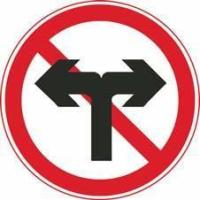
A、No U turn at intersection
B、No changing lane from both sides
C、No left or right turn
D、No going straight
Answer:C
17、When a tire blowout on the road, the driver should control the direction of the vehicle and use emergency braking to bring the motorcycle swiftly to a stop.
A、Right
B、Wrong
Answer:B
18、What is the meaning of this sign?

A、Downhill section on right side
B、Driving by the right side of the road
C、Stopping by the right side of the road
D、Right turn only
Answer:B
19、What is the meaning of this sign?
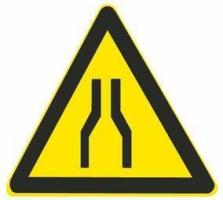
A、Road narrows on both sides
B、Road narrows on the right side
C、Road narrows on the left side
D、Bridge narrows
Answer:A
20、What is the meaning of this sign?

A、No yielding
B、Yield while crossing each other
C、Reduce speed and yield
D、Stop to yield
Answer:C
21、The main impact of muddy roads on safe driving is that the wheels may easily spin and skid
A、Right
B、Wrong
Answer:A
22、Speed up and pass when encountering this traffic light at the intersection
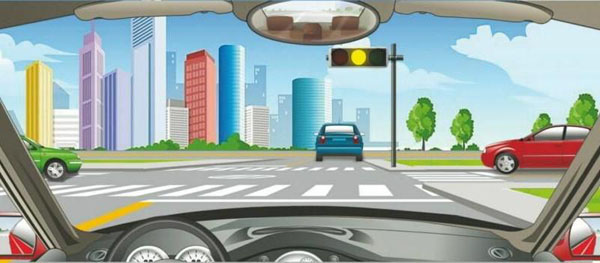
A、Right
B、Wrong
Answer:B
23、When a motorcycle passing through an interchange discovers it has chosen a wrong route, it should immediately make a U turn from where it is or reverse to change route.
A、Right
B、Wrong
Answer:B
24、The motorized vehicle driver may go through an intersection rapidly when there is no traffic signal
A、Right
B、Wrong
Answer:B
25、While driving a motorcycle, nothing is permitted to hang on the handlebars.
A、Right
B、Wrong
Answer:A